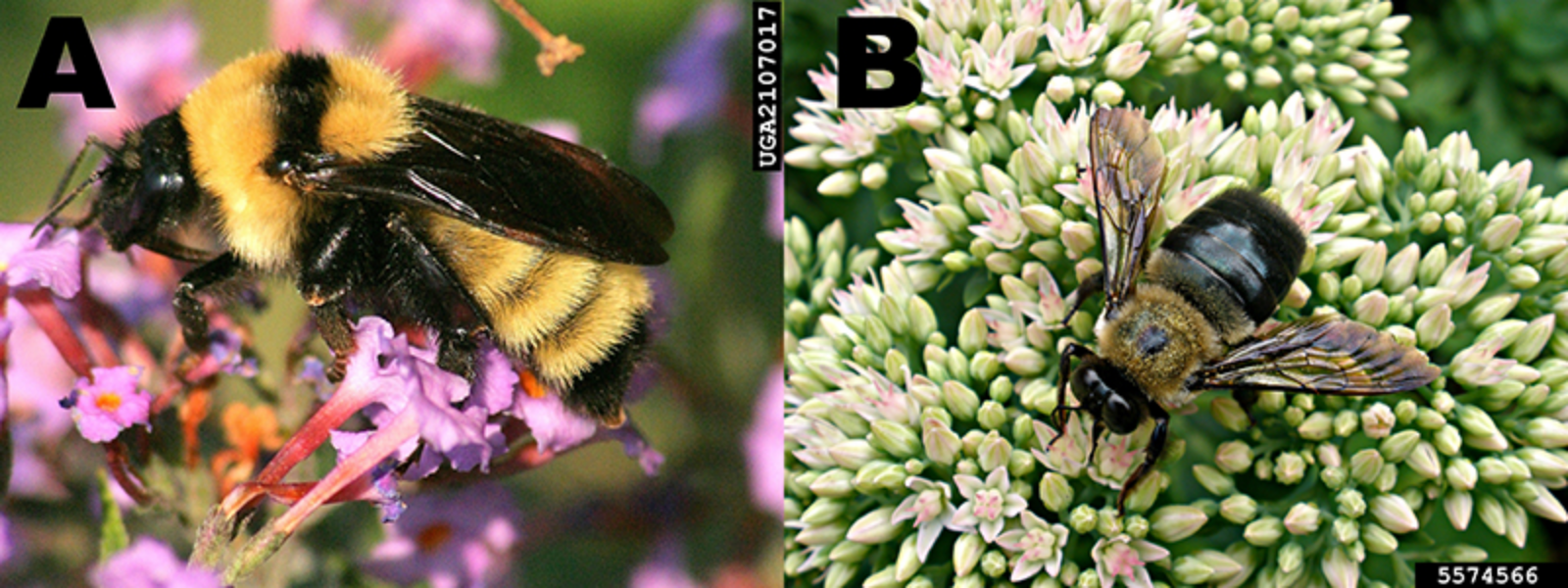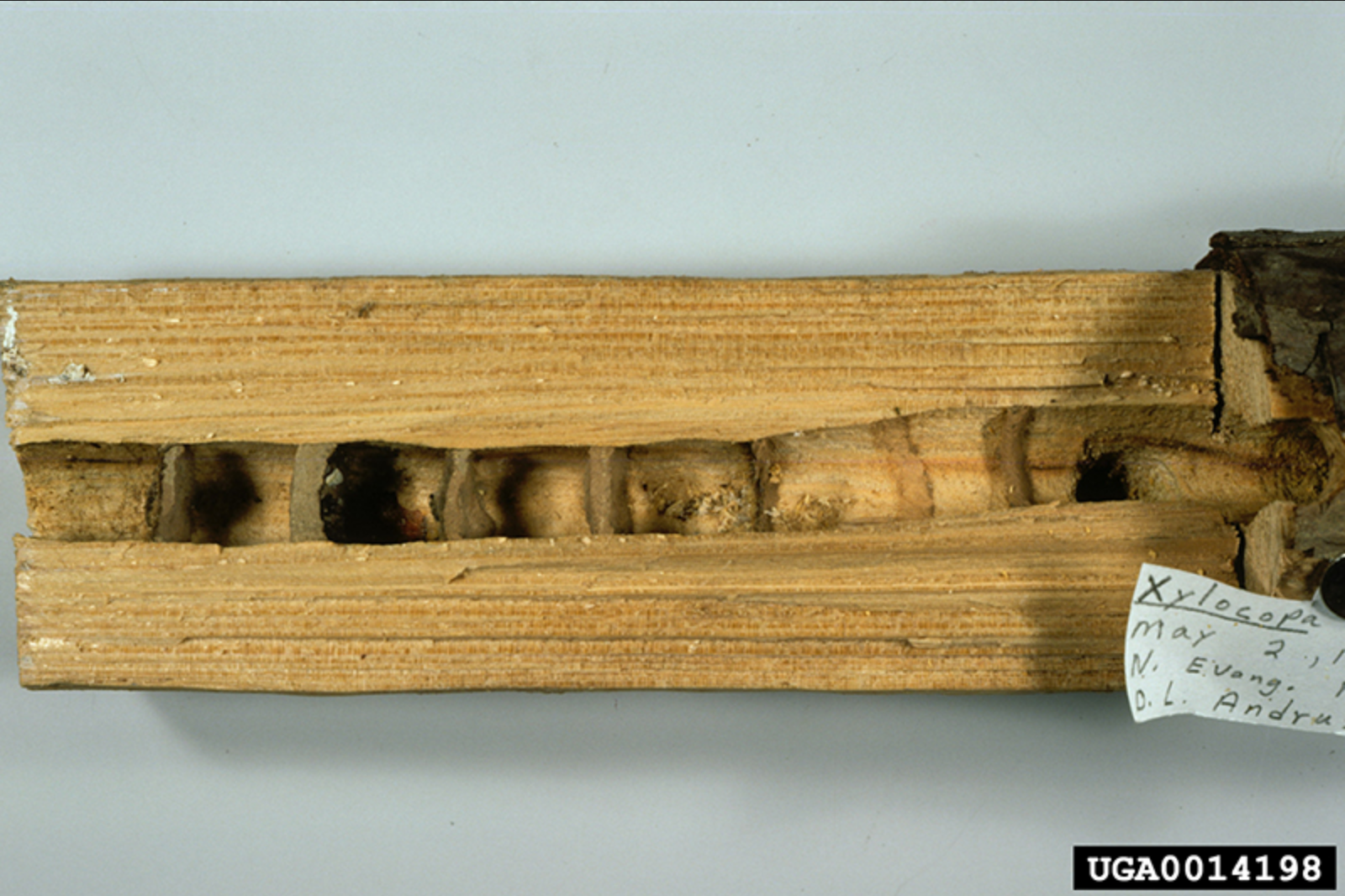Picture of the Week
June 7, 2021
Carpenter bees: What’s that buzzing around your porch?
Elizabeth Barnes, Exotic Forest Pest Educator, Purdue University
Have you noticed large bees buzzing around your woodpile? Or maybe near your porch? There’s a good chance you’ve encountered carpenter bees. Carpenter bees are large, solitary bees that people often notice in the spring when the bees build their nests. Female bees tunnel into wood using their strong mandibles. The entrance holes to these tunnels are typically about ½ inch wide (about the size of your pinky finger) and perfectly round (Image 1). Each tunnel is outfitted with several cells that the females will stuff with pollen and lay a single egg in (Image 2). Once the eggs hatch, the larval bees feed on the pollen until they are large enough to pupate and emerge as adults.
Click image to enlarge
Carpenter bees only tunnel into dead wood. If you find a perfectly round hole in a living or recently living tree, you may have found evidence of the highly destructive invasive species Asian longhorned beetle. If you think you’ve found evidence of this beetle, please report it!
How do I know if I’ve seen a carpenter bee?
Bumble bees are often confused with carpenter bees. The quickest way to tell them apart is to look at their abdomen. Bumble bees typically have fuzzy abdomens (Image 3 a) whereas carpenter bees have shiny, black abdomens (Image 3 b). If you’re still unsure if you’ve seen a carpenter bee, we suggest trying out the iNaturalist app or website. This project can help you to identify all sorts of organisms and your observation will be added to an international biodiversity project. You can also send a specimen to Purdue’s Plant and Pest Diagnostic lab to be identified for a small fee.
 IMAGE 3: Carpenter bees are often confused with bumble bees. You can tell them apart by looking at their abdomens: bumble bees typically have fuzzy abdomens (a) and carpenter bees have black, shiny abdomens (b). Photos by David Cappaert and Ansel Oommen.
IMAGE 3: Carpenter bees are often confused with bumble bees. You can tell them apart by looking at their abdomens: bumble bees typically have fuzzy abdomens (a) and carpenter bees have black, shiny abdomens (b). Photos by David Cappaert and Ansel Oommen. Do they sting?
Seeing several large bees buzzing around your home can seem quite threatening but these bees are mostly harmless. Male bees can seem aggressive but can’t sting. Females can sting, but they rarely do so. In most cases, they will only sting if held tightly in your hand or if you directly attack their nest. Male bees can be distinguished from female bees by the yellow square on their face.
How much damage do they cause?
The amount of damage that these bees cause varies widely between locations but, in most cases, the damage is relatively minor. Carpenter bees like to re-use the same tunnels year after year rather than building new ones. Once they’ve built a tunnel, they are unlikely to expand it further. However, in some cases, they can cause cosmetic or structural issues. The tunnels can also allow moisture to get into the wood and cause further damage. In addition, woodpeckers occasionally enlarge carpenter bees’ tunnels to eat the larvae inside.
How can I protect my property?
The best way to protect your property is to discourage the bees from nesting where you don’t want them in the first place. Carpenter bees prefer unpainted, soft wood and will generally avoid painted wood, pressure treated wood, and hard woods. Taking preemptive measures like painting wood or using hardwood in construction can discourage the bees from tunneling into areas you don’t want them. However, this will not always guarantee protection. We have outlined further treatment methods using a combination of insecticides and filling in the bee’s tunnels in our bulletin on Carpenter Bees.
Do they have positive impacts?
Carpenter bees, like many native solitary bees, are excellent and important pollinators. If you have a garden or flowering tree, you might have these bees to thank for some of your harvest!
Additional Resources:
Solitary Bees and Wasps: Carpenter Bee, Cicada Killer, and Mud Daubers
This article was originally in The Purdue Landscape Report Issue 21-07



